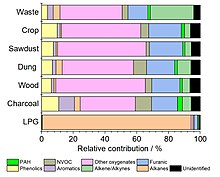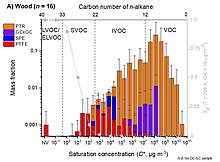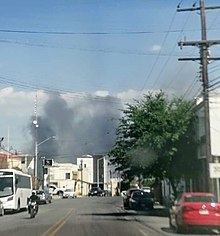
Back Fumo AN دخان (كيمياء) Arabic ܬܢܢܐ ARC Jiwq'i Aymara Dūmā BAT-SMG Aso BCL Дым Byelorussian Дым BE-X-OLD Дим Bulgarian धुआँ Bihari






Smoke is a suspension[3] of airborne particulates and gases[4] emitted when a material undergoes combustion or pyrolysis, together with the quantity of air that is entrained or otherwise mixed into the mass. It is commonly an unwanted by-product of fires (including stoves, candles, internal combustion engines, oil lamps, and fireplaces), but may also be used for pest control (fumigation), communication (smoke signals), defensive and offensive capabilities in the military (smoke screen), cooking, or smoking (tobacco, cannabis, etc.). It is used in rituals where incense, sage, or resin is burned to produce a smell for spiritual or magical purposes. It can also be a flavoring agent and preservative.

Smoke inhalation is the primary cause of death in victims of indoor fires. The smoke kills by a combination of thermal damage, poisoning and pulmonary irritation caused by carbon monoxide, hydrogen cyanide and other combustion products.
Smoke is an aerosol (or mist) of solid particles and liquid droplets that are close to the ideal range of sizes for Mie scattering of visible light.[5]
- ^ Stewart, Gareth J.; Acton, W. Joe F.; Nelson, Beth S.; Vaughan, Adam R.; Hopkins, James R.; Arya, Rahul; Mondal, Arnab; Jangirh, Ritu; Ahlawat, Sakshi; Yadav, Lokesh; Sharma, Sudhir K.; Dunmore, Rachel E.; Yunus, Siti S. M.; Hewitt, C. Nicholas; Nemitz, Eiko; Mullinger, Neil; Gadi, Ranu; Sahu, Lokesh K.; Tripathi, Nidhi; Rickard, Andrew R.; Lee, James D.; Mandal, Tuhin K.; Hamilton, Jacqueline F. (18 February 2021). "Emissions of non-methane volatile organic compounds from combustion of domestic fuels in Delhi, India". Atmospheric Chemistry and Physics. 21 (4): 2383–2406. Bibcode:2021ACP....21.2383S. doi:10.5194/acp-21-2383-2021.
- ^ Stewart, Gareth J.; Nelson, Beth S.; Acton, W. Joe F.; Vaughan, Adam R.; Hopkins, James R.; Yunus, Siti S. M.; Hewitt, C. Nicholas; Nemitz, Eiko; Mandal, Tuhin K.; Gadi, Ranu; Sahu, Lokesh. K.; Rickard, Andrew R.; Lee, James D.; Hamilton, Jacqueline F. (2021). "Comprehensive organic emission profiles, secondary organic aerosol production potential, and OH reactivity of domestic fuel combustion in Delhi, India". Environmental Science: Atmospheres. 1 (2): 104–117. doi:10.1039/D0EA00009D.
- ^ "15.11: Colloids". Chemistry LibreTexts. 27 June 2016. Archived from the original on 23 November 2022. Retrieved 23 November 2022.
- ^ "Smoke Production and Properties" (PDF). SFPE Handbook of Fire Protection Engineering. Archived from the original (PDF) on 21 August 2008.
- ^ The Virginia Journal of Science. Virginia Academy of Science. 1976. Archived from the original on 19 August 2020. Retrieved 5 July 2020.[page needed]
© MMXXIII Rich X Search. We shall prevail. All rights reserved. Rich X Search